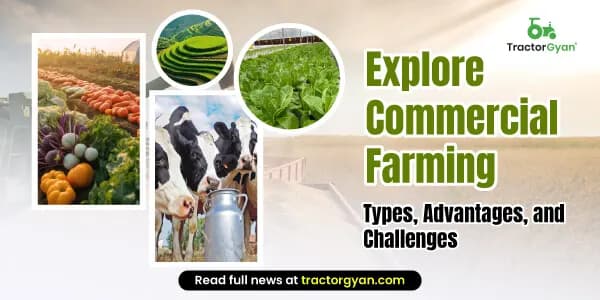What is Urban farming : Importance, Types, Advantages & Disadvantages of Urban Agriculture
Table of Content
Welcome to the fascinating world of urban farming! Have you ever wondered how we can bring the joys of farming right into the heart of our bustling cities? Well, urban farming is the answer!
In this blog, we will dive into the captivating realm of urban farming in India, exploring urban agriculture significance as a sustainable solution for ensuring food security in urban areas. With the rapid urbanization and population growth experienced in the country, the need for innovative approaches to meet the increasing demand for food has become paramount. Urban agriculture, a practice that involves cultivating crops and rearing livestock within urban environments, has emerged as a promising solution to address this challenge. This article aims to shed light on the various aspects of urban farming in India, including its types, advantages, disadvantages, challenges, and potential for future growth.
What is Urban Farming?
Urban farming can be defined as the cultivation of crops and rearing of animals within urban or peri-urban areas. Unlike traditional farming, which predominantly occurs in rural settings, urban farming takes advantage of available spaces in cities, such as rooftops, balconies, community gardens, and vacant lots. Urban agriculture is an innovative approach to address the challenges posed by urbanization, limited land availability, and the need for sustainable food production.
Importance of Urban Farming in India
Urban farming plays a crucial role in ensuring food security in India's urban areas. By bringing agriculture closer to consumers, it reduces the reliance on long-distance transportation, thereby minimizing carbon emissions and promoting environmental sustainability. Additionally, urban farming provides an opportunity for individuals to reconnect with nature, fostering a sense of community and promoting a healthier lifestyle. Moreover, urban agriculture offers economic benefits by creating employment opportunities and supporting local economies.
Types of Urban Farming in India

1. Rooftop Farming

One of the most popular urban farming methods is rooftop farming. Utilizing the often underutilized space on rooftops, this urban Farming method involves growing crops in containers or raised beds. Rooftop farms not only provide fresh produce but also contribute to insulation, stormwater management, and reduction of the urban heat island effect.
2. Vertical Farming

Vertical farming is a cutting-edge urban agriculture technique that involves growing crops in vertically stacked layers, often in controlled environments such as indoor facilities or greenhouses. By utilizing advanced technologies like hydroponics or aeroponics, vertical farms maximize space efficiency and optimize resource utilization, enabling year-round production of crops.
3. Community Gardens

Community gardens are collaborative spaces where individuals or groups come together to cultivate plants collectively. These gardens are typically located on shared land, such as parks or vacant lots, and provide an opportunity for community members to grow their food, foster social connections, and promote environmental awareness.
4. Indoor Farming

Indoor farming refers to the cultivation of crops within enclosed structures, such as warehouses or shipping containers. By controlling environmental factors like temperature, light, and humidity, indoor farms can create optimal growing conditions, independent of external weather conditions. This urban farming method allows for year-round production and reduces the reliance on traditional agricultural practices.
5. Hydroponics

Hydroponic farming is a type of urban farming in which plants are grown without the soil wherein nutrients are added to water those plants that are immersed and regularly the roots of those plants are washed.
Chemical fertilizers or organic stuff like manure can be used in hydroponic systems.
Hydroponic systems can reduce the amount of water needed to grow crops because water is recycled and reused in them. Plants can be grown with hydroponics in environments that are too severe for soil-based cultivation. When people decide to travel to Mars, it might even be used to cultivate plants in space.
6. Microgreen

Microgreen farming is a type of urban farming. It is the practice of growing microgreens for commercial purposes in a small space, such as a backyard.
Depending on how you approach it, you can control many of the factors that frequently affect farming, such as sunlight, temperature, and water. Greater controllability translates into lower risk and greater profit.
Naturally, microgreen seeds, planting trays, soil, and grow lights are all necessary for indoor microgreen cultivation instead of the sun. It's a good idea to invest in timers to automate when the grow lights turn on if you're generating a respectable amount.
7. Aquaponics

Recirculating aquaculture - the practice of producing fish in tanks - and soilless plant culture are combined in aquaponics, a type of agriculture (hydroponics). In aquaponics (urban farming example), the plants are naturally fertilized by nutrient-rich fish-raising water, and the plants also aid in the fish's water purification.
Using pricey, man-made nutrients that are carefully applied to the soil in traditional hydroponic systems, a cocktail of chemicals, salts, and trace elements is what makes them work. In aquaponics, you only give your fish cheap fish food, leftover food, and food that you have grown yourself.
It is a system for growing food. Fish are raised in water tanks in aquaponics. In these tanks, plants also grew, and the fish waste served as plant manure. Plants use this to keep the water clean. As a result, it is a successful method for harvesting crops and replacing protein.
Urban Farming Benefits in India

1. Increased Food Production: Urban farming allows for the cultivation of fresh produce in areas where traditional agriculture is limited. By utilizing innovative techniques such as vertical farming and hydroponics, urban farmers can maximize crop yields and optimize land use.
2. Improved Food Quality: The next advantage of urban farming is to have access to fresh, pesticide-free produce, ensuring higher nutritional value and reducing health risks associated with chemical residues.
3. Enhanced Food Security: By reducing dependence on external food sources, urban farming strengthens food security in urban areas, particularly during times of crisis or disruptions in the supply chain.
4. Environmental Sustainability: Urban farming promotes sustainable practices such as composting, rainwater harvesting, and waste reduction, contributing to a greener and more resilient urban ecosystem.
5. Community Engagement: Engaging in urban farming fosters a sense of community and social cohesion. Urban agriculture provides an opportunity for individuals to connect with nature, learn about agriculture, and develop a deeper appreciation for the food they consume. Moreover, community gardens and shared spaces can serve as platforms for knowledge exchange and skill-building.
6. Economic Opportunities: Another Urban farming benefit is to generate economic opportunities, particularly for marginalized communities. By cultivating and selling their produce locally, individuals can create small-scale businesses, contributing to their financial stability and reducing unemployment rates.
Urban Farming Disadvantages in India

1. Limited Space:
One of the primary challenges of urban farming in India is the scarcity of available land. Rapid urbanization has led to a reduction in open spaces, making it difficult to establish large-scale farms. This limitation restricts the potential yield and variety of crops that can be cultivated.
2. Soil Contamination:
Urban areas often suffer from soil contamination due to industrial activities, pollution, and improper waste disposal. This poses a significant challenge for urban farmers, as contaminated soil can negatively impact crop quality and pose health risks to consumers.
3. Water Management:
Urban farming requires efficient water management, as water scarcity is a prevalent issue in many Indian cities. Adequate irrigation systems and responsible water usage are crucial to ensure the sustainability of urban farms.
4. Regulatory Challenges:
Navigating the regulatory framework surrounding urban farming can be complex. Obtaining necessary permits, adhering to zoning regulations, and addressing potential conflicts with existing urban infrastructure can pose significant hurdles for aspiring urban farmers.
How to start Urban Farming in India?
1. Understanding the Concept of Urban Farming:
To begin, it is crucial to grasp the knowledge of urban farming. Urban farming refers to the cultivation of crops, rearing of livestock, and production of food within urban areas. Urban agriculture practice utilizes limited spaces such as rooftops, balconies, community gardens, or even vertical structures to maximize productivity while minimizing the ecological footprint.
2. Conducting a Feasibility Study:
Before initiating an urban farm, conducting a thorough feasibility study is imperative. This study should encompass various aspects, including available space, sunlight exposure, water availability, soil quality, and legal regulations. By assessing these factors, one can determine the viability of urban farming in their specific location.
3. Selecting Suitable Crops and Livestock:
Choosing the right crops and livestock is a crucial step in urban farming. Factors such as climate, available space, and market demand should be considered. Opting for locally adapted and high-yielding varieties can enhance productivity and profitability. Additionally, exploring the potential for organic farming practices can contribute to sustainable and healthier food production.
4. Acquiring Necessary Resources:
To establish an urban farm, certain resources are essential. These include seeds, fertilizers, tools, irrigation systems, and appropriate infrastructure. Collaborating with local agricultural institutions, government bodies, or non-profit organizations can provide valuable guidance and support in procuring these resources.
5. Implementing Sustainable Practices:
Urban farming should prioritize sustainable practices to minimize environmental impact. Utilizing organic fertilizers, implementing efficient water management techniques, and adopting integrated pest management strategies are crucial steps toward sustainable urban farming. Additionally, exploring innovative techniques such as hydroponics or aquaponics can maximize productivity while conserving resources.
6. Engaging the Community:
Urban farming has the potential to foster community engagement and social cohesion. Encouraging participation from local residents, schools, or community organizations can create a sense of ownership and shared responsibility. Collaborative initiatives such as community gardens or farmers' markets can further promote the benefits of urban farming and strengthen community bonds.
Challenges and Solutions in Urban Farming
While urban farming presents numerous benefits, it also faces certain challenges in the Indian context. Limited space, lack of awareness, and inadequate infrastructure are some of the obstacles hindering urban agriculture's widespread adoption.
However, these urban agriculture challenges can be addressed through initiatives such as rooftop farming, community gardens, and educational programs to raise awareness about the importance of urban farming. Additionally, government support in the form of policy incentives and funding can play a crucial role in promoting urban farming practices.
The Future of Urban Farming in India
The potential for urban farming in India is immense. As the country continues to urbanize, the demand for locally produced, sustainable food will only increase.
Conclusion
Urban farming or urban agriculture is a captivating concept that holds immense potential for transforming our cities into greener, healthier, and more self-sufficient spaces. Urban agriculture allows us to reconnect with nature, promote sustainable living, and foster a sense of community. Moreover, it encompasses a range of innovative approaches to food production within urban environments. Through urban farming practices like rooftop farming, vertical farming, community gardens, and indoor farming, urban dwellers can actively participate in sustainable agriculture.
Category
Read More Blogs
Apricot is a fruit that is important and mainly grown in the dry temperate and mid-hill regions of India. Original apricots are from China whereas the wild apricot which is known as the Zardalu’ is indigenous to India.
A type of self-pollinating plant, apricot...
Shifting cultivation is a form of farming method which is practiced by millions of people across the world, especially in south-east Asia. It was first considered environmentally destructive, but now with much research, it has been concluded that shifting cultivation can be...
Apiculture is the technique or farming practice that involves the production of honey, beeswax, royal jelly, flower pollen, and bee pollen. The process is also known as beekeeping. So, Technically Apiculture is bee farming. This process of farming involves the cultivation of...
Write Your Comment About What is Urban farming : Importance, Types, Advantages & Disadvantages of Urban Agriculture
.webp&w=1920&q=75)
Top searching blogs about Tractors and Agriculture
30 Jul 2025
30 Jul 2025
29 Jul 2025
08 Sep 2025
03 Jul 2025
30 Jul 2025
30 Jul 2025
30 Jul 2025
29 Jul 2025
30 Jul 2025
29 Sep 2025
31 Jul 2025
30 Jul 2025
31 Jul 2025















.webp&w=3840&q=75)










.webp&w=3840&q=75)
.webp&w=3840&q=75)



























